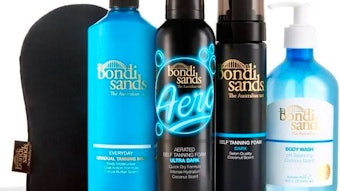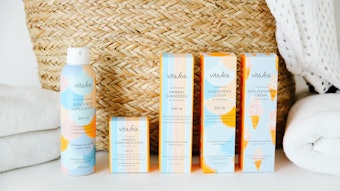
According to Euromonitor International, growth of the U.S. market is expected to be 9% over the 2005-2010 period. Globally, the 2005 sun care market of $5.6 billion is forecast to reach $7.2 billion by 2010. Innovations in value-added products is expected to drive growth of 2%. The evolution of the sun care market does not end with protection properties or even sun protection products themselves, and the increased focus on developing products for after-sun exposure (moisturizing and soothing properties), increased focus on self-tanning products and a shift in focus from beach-oriented products to daily-use skin care applications have dramatically altered the look of the segment.
Beyond SPF
“Over the past 10 years, there has been dramatic increase in demand for sun care,” said Rob van der Meij, global business manager alcohol & derivatives, Shell Chemicals. “With better consumer understanding of skin health and widespread sun-safety awareness campaigns—particularly in markets such as the U.S., U.K. and Australia—consumer demand has fuelled growth in the sector. In addition, consumers have become increasingly discerning, demanding a wider variety of qualities from the products—from water resistance and durability to absorption and self tanning. This has led to considerable innovation and a proliferation of sun care products on the market.”
Thomas Russo, formulations manager at Lipo Chemicals Inc., notes that products have evolved by providing improved SPF performance and improved UV broad spectrum protection—UVB and UVA (as consumer knowledge on the long-term skin damage caused from UVA sun exposure grows, manufacturers are formulating with more effective UVA sunscreens). However, improved skin feel, improved water proofing and water-resistant performance, and innovations in product application also have been an important part of this evolution.
“Today’s sun care products perform better, feel better and are more versatile and multifunctional than they were 10 years ago,” said Craig A. Bonda, director, R&D, personal care, CPH Innovations, RTDHallStar. “These advances are the direct result of new raw materials and a better understanding by formulators of sunscreen photochemistry and skin biology.”
“By developing products that not only protect from the sun but have creamy, non-sticky formulations (that) enhance skin softness and appearance, consumers are encouraged to use sun care products,” said van der Meij. “Due to the nature of sun care, it is important that products are easy to apply and comfortable to wear. The feeling of the product on the skin and the evenness of application are crucial to its marketability, especially in today’s competitive sun care market.”
“Our customers, the formulators of sun care products, have challenged ingredient suppliers to help them deliver both high SPF and sensory aesthetics, including irritation reduction,” said Mary Clarke, director of sales development, Croda.
“Cosmetic chemists have to develop sunscreen formulations with a very limited number of approved sunscreens,” said Ratan Chaudhuri, technical advisor, EMD Chemicals, Inc.; president, Sytheon Ltd. “Sunscreens are now included in a wide variety of skin care/protection products such as day care, self-tanning, insect-repellent products. Lotions and creams are the most desired and elegant forms of delivery. Gels, sticks, mousses, aerosol have remained as niche delivery systems due to the difficulty in preparation and lack of aesthetics.”
According to Chaudhuri, Avobenzone was approved for use in the U.S. market approximately 10 years ago, and it was followed by micronized TiO2 and ZnO (approved in the U.S. in 1998). These three sunscreens provided formulators with more flexibility in developing true broad spectrum sunscreens, and developments in photostabilization of UV filters have changed sunscreen formulations—allowing sunscreen to go from just delivering broad-spectrum SPF protection to photostable broad-spectrum protection.
RTDHallStar has developed several technologies and additives that improve the delivery of broad-spectrum protection by improving sunscreen photostability—including HallBrite BHB, HallBrite TQ, the Spectrasolv line and Polycrylene—and it is of interest to note that even as he lists the sun protection attributes of these ingredients, Bonda points out that HallBrite BHB also has been shown to improve sunscreen aesthetics. Aesthetics, in addition to actives, are important enough to consider at the ingredient level, and ingredient suppliers actively work to provide both. Lipo Chemicals’ products for the market, for example, include: Lipo CD-OMC, a sunscreen active agent; Lipo Padimate O, a sunscreen active; Gorgonian Extracts GC, PTG, anti-inflammatory agents; and Panalane H-300E, a waterproofing agent.
EMD/Merck has developed a number of products designed to provide improved skin protection. Oxynex ST, delivers a high level of photostabilization to Avobenzone and, hence, better skin protection. RonaCare Emblica, a broad-spectrum antioxidant with iron chelating and matrix metalloprotease inhibitory properties, is another product introduced by EMD/Merck for improving skin protection as well as appearance. With an eye toward improved aesthetics, UV-Pearls OMC has been introduced as the next generation safe and inert UV filter. According to Chaudhuri, they do not penetrate the skin, even hours following application. Because of the small particle size (roughly 1 micron) and its incorporation in water suspension, these sol-gel microcapsules have a pleasant skin feel.
Shell Chemicals has seen the volume of its NEODOL alcohols supplied to the personal care market double from 2003 to 2004, and expects similar results in its 2005-2006 numbers with a boost from the sun-care market.
Shell recognized the increasing need for alcohols that can impart both performance and aesthetic qualities, and focused more closely on specific requirements. For sun care products, there is a particular demand for attributes such as absorption, feel and water resistance that can, again, be combined with a reliable and higher level of SPF protection.
“Today, the market for every day sun care products and combination sun care products such as facial moisturizers is rapidly growing. Aesthetic attributes are almost as important as the protection offered,” said van der Meij. “In markets such as the U.K. and North America where demand for sun care has traditionally been seasonal, this creates buoyancy all year round.”
“The changes in sun care products are driven both by the consumer and the manufacturer,” said Melissa Frischling, director of marketing, Lipo Chemicals. “The consumer wants better skin-feel attributes and more effective UV protection. The leading manufactures also want these benefits in their products for improved market focus, market share and a competitive edge. Manufacturers try to develop new and improved forms for applying sun care products, and have expanded the non-SPF product offerings for after-sun exposure and sunless (tanners).”
“Today’s consumers are more educated about the long term affects of exposure to the sun, and are looking for a higher level of protection,” said Chaudhuri “This has led to a growing demand—not only for broad-spectrum sunscreens with cosmetic attributes, but, in addition, skin care and protection products containing UV filters. Manufacturers of sunscreens have responded by including skin care actives, antioxidants, anti-inflammatory agents, etc. that demonstrate the additional skin care benefits the consumer is asking for.”
“Manufacturers want to deliver new and improved products; consumers want products that provide performance, value and, if possible, some level of enjoyment while using them,” said Bonda. “Not too long ago, people put on sunscreen for the same reason they put on oven mitts, to keep from burning—and many still do. But many more people today understand that chronic exposure to the sun’s UV radiation is the single greatest preventable cause of skin aging. So they demand products that they can wear every day, especially on the face, that help preserve their skin’s youthful appearance. Manufacturers are serving this demand with a new generation of high performance products with excellent esthetics.”










